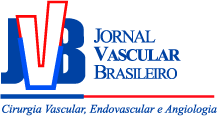Real time echo-guided endolaser for thermal ablation without perivenous tumescence
Endolaser ecoguiado em tempo real para termoablação sem intumescência perivenosa
Ricardo José Gaspar; André Nóbrega Castro; Manuel de Jesus Simões; Hélio Plapler
Abstract
Keywords
Resumo
Palavras-chave
References
Proebstle TM, Moehler T, Gul D, Herdemann S. Endovenous treatment of the great saphenous vein using a 1,320 nm Nd:YAG laser causes fewer side effects than using a 940 nm diode laser. Dermatol Surg. 2005;31(12):1678-83.
Proebstle TM, Lehr HA, Kargl A. Endovenous treatment of the greater saphenous vein with a 940-nm diode laser: thrombotic occlusion after endoluminal thermal damage by laser-generated steam bubbles. J Vasc Surg. 2002;35(4):729-36.
Bush RG. Regarding “Endovenous treatment of the greater saphenous vein with a 940-nm diode laser: thrombolytic occlusion after endoluminal thermal damage by laser-generated steam bubbles”. J Vasc Surg. 2003;37(1):242.
Kim HS, Nwankwo IJ, Hong K, McElgunn PS. Lower energy endovenous laser ablation of the great saphenous vein with 980 nm diode laser in continuous mode. Cardiovasc Intervent Radiol. 2006;29(1):64-9.
Palmieri B, Lapilli A, Benuzzi G. Endoluminal diode laser vein damage: preclinic study for vein insufficiency. Minerva Cardioangiol. 2003;51(1):95-9.
Proebstle TM, Sandhofer M, Kargl A. Thermal damage of the inner vein wall during endovenous laser treatment: key role of energy absorption by intravascular blood. Dermatol Surg. 2002;28(7):596-600.
Perkowski P, Ravi R, Gowda RC. Endovenous laser ablation of the saphenous vein for treatment of venous insufficiency and varicose veins: early results from a large single-center experience. J Endovasc Ther. 2004;11(2):132-8.
Campbell B. New treatments for varicose veins. BMJ. 2002;324(7339):689-90.
Lefebvre-Vilardebo M. The sapheno-femoral area: anatomic study and concepts for the prevention of varicose recurrences. J Mal Vasc. 1991;16(4):355-8.
Min RJ, Zimmet SE, Isaacs MN, Forrestal MD. Endovenous laser treatment of the incompetent greater saphenous vein. J Vasc Interv Radiol. 2001;12(10):1167-71.
Navarro L, Min RJ, Bone C. Endovenous laser: a new minimally invasive method of treatment for varicose veins--preliminary observations using an 810 nm diode laser. Dermatol Surg. 2001;27(2):117-22.
Goldman MP, Mauricio M, Rao J. Intravascular 1320-nm laser closure of the great saphenous vein: a 6- to 12-month follow-up study. Dermatol Surg. 2004;30(11):1380-5.
Hingorani AP, Ascher E, Markevich N. Deep venous thrombosis after radiofrequency ablation of greater saphenous vein: a word of caution. J Vasc Surg. 2004;40(3):500-4.
Proebstle TM, Krummenauer F, Gul D, Knop J. Nonocclusion and early reopening of the great saphenous vein after endovenous laser treatment is fluence dependent. Dermatol Surg. 2004;30(2 Pt 1):174-8.
Gloviczki P. Endovenous treatment of varicose veins: credentialing, quality control and education. Endovascular Today.. 2004;1(^sSuppl):28-9.
Maffei FHA. Diagnóstico clínico das doenças venosas periférica. Doenças vasculares periféricas. 2002:457-69.
Corcos L, Dini S, Anna D. The immediate effects of endovenous diode 808-nm laser in the greater saphenous vein: morphologic study and clinical implications. J Vasc Surg. 2005;41(6):1018-24, discussion 25.
Proebstle TM, Moehler T, Herdemann S. Reduced recanalization rates of the great saphenous vein after endovenous laser treatment with increased energy dosing: definition of a threshold for the endovenous fluence equivalent. J Vasc Surg. 2006;44(4):834-9.
Boné Salat C. Tratamiento endoluminal de las varices con láser de diodo: estudio preliminar. Rev Patol Vasc.. 1999;5:35-46.
Bush RG, Shamma HN, Hammond K. Histological changes occurring after endoluminal ablation with two diode lasers (940 and 1319 nm) from acute changes to 4 months. Lasers Surg Med. 2008;40(10):676-9.
Hoggan BL, Cameron AL, Maddern GJ. Systematic review of endovenous laser therapy versus surgery for the treatment of saphenous varicose veins. Ann Vasc Surg. 2009;23(2):277-87.
Leopardi D, Hoggan BL, Fitridge RA, Woodruff PW, Maddern GJ. Systematic review of treatments for varicose veins. Ann Vasc Surg. 2009;23(2):264-76.
Medeiros CAF. Comparação entre o laser endovenoso e a fleboextração total da veia safena interna: resultados em médio prazo. J Vasc Bras. 2006;5(4):277-87.
Viarengo LMA, Meirelles GV, Potério Filho J. Tratamento de varizes com laser endovenoso: estudo prospectivo com seguimento de 39 meses. J Vasc Bras. 2006;5(3):184-93.
Gérard JL, Desgranges P, Becquemin JP, Desse H, Melliere D. Feasibility of ambulatory endovenous laser for the treatment of greater saphenous varicose veins: one-month outcome in a series of 20 outpatients. J Mal Vasc. 2002;27(4):222-5.
Almeida J, Mackay E, Javier J, Mauriello J, Raines J. Saphenous laser ablation at 1470 nm targets the vein wall, not blood. Vasc Endovascular Surg. 2009;43(5):467-72.
Doganci S, Demirkilic U. Comparison of 980 nm laser and bare-tip fibre with 1470 nm and radial fibre in the treatment of great saphenous vein varicosities: a prospective randomised clinical trial. Eur J Vasc Endovasc Surg. 2010;40(2):254-9.
Vuylsteke ME, Thomis S, Mahieu P, Mordon S, Fourneau I. Endovenous laser ablation of the great saphenous vein using a bare fibre versus a tulip fibre: a randomized clinical trial. Eur J Vasc Endovasc Surg. 2012;44(6):587-92.
Corcos L, Dini S, Peruzzi G, Pontello D, Dini M, De Anna D. Duplex ultrasound changes in the great saphenous vein after endosaphenous laser occlusion with 808-nm wavelength. J Vasc Surg. 2008;48(5):1262-71.
Gaspar RJ, Simões MJ, Plapler H. Effects of the endolaser in the great saphenous vein to treat the chronic venous insufficiency. J Vasc Bras. 2011;10(1):81-2.
Carradice D, Mekako AI, Hatfield J, Chetter IC. Randomized clinical trial of concomitant or sequential phlebectomy after endovenous laser therapy for varicose veins. Br J Surg. 2009;96(4):369-75.
Theivacumar NS, Darwood RJ, Dellagrammaticas D, Mavor AI, Gough MJ. The clinical significance of below-knee great saphenous vein reflux following endovenous laser ablation of above-knee great saphenous vein. Phlebology. 2009;24(1):17-20.

